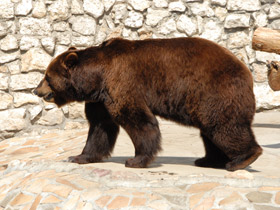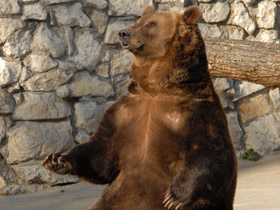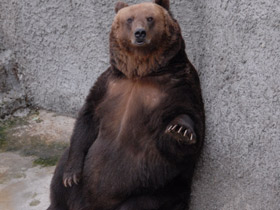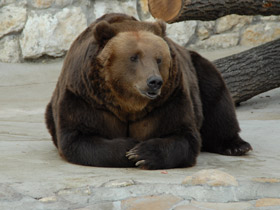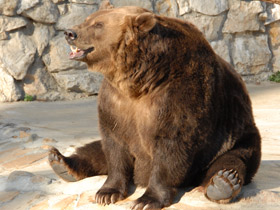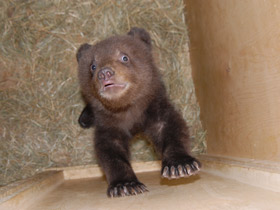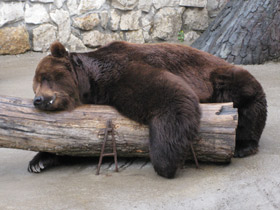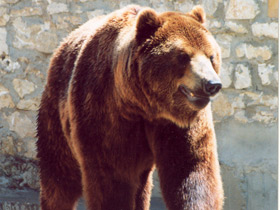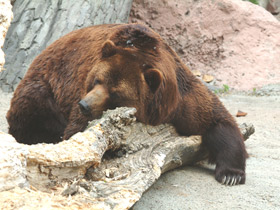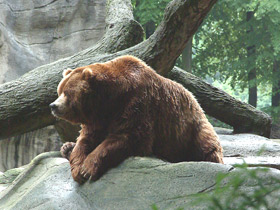The brown bear (Ursus arctos)
The brown bear (Ursus arctos) is a large bear species found across Eurasia and North America. In North America, the populations of brown bears are called grizzly bears, while the subspecies that inhabits the Kodiak Islands of Alaska is known as the Kodiak bear. It is one of the largest living terrestrial members of the order Carnivora, rivaled in size only by its closest relative, the polar bear (Ursus maritimus), which is much less variable in size and slightly bigger on average. The brown bear's range includes parts of Russia, Central Asia, the Himalayas, China, Canada, the United States, Hokkaido, Scandinavia, Finland, the Balkans, the Picos de Europa and the Carpathian region (especially Romania), Iran, Anatolia, and the Caucasus. The brown bear is recognized as a national and state animal in several European countries.
Evolution and taxonomy
The brown bear is sometimes referred to as the bruin, from Middle English. This name originated in the fable History of Reynard the Fox translated by William Caxton from Middle Dutch bruun or bruyn, meaning brown (the color). In the mid-19th century United States, the brown bear was termed "Old Ephraim" and sometimes as "Moccasin Joe".
The scientific name of the brown bear, Ursus arctos, comes from the Latin ursus, meaning "bear", and the Greek ἄρκτος/arktos, also meaning "bear".
Appearance and peculiarities
Ursus arctos is a species of carnivorous mammal of the family Ursidae.
Ursus arctos is one of the largest carnivores on the planet. Giants weighing up to 750 kg and measuring over 2.5 m in length can still be found today, and standing on their haunches, they reach up to three metres in height. Ursus arctos is an extremely powerful and dangerous beast (photo 1, 2, 3, 4); not without reason it is called the "master of the forest". Despite its clumsy appearance, it can reach speeds of up to 50 km/h when necessary, swims well and is a good tree climber when young.
A characteristic feature of the Ursus arctos is its winter sleep in a den. In this state, bears are able to live for more than six months without eating, drinking or excreting. The length of winter sleep varies from 75 to 195 days in different areas.
Hybrids
A grizzly–polar bear hybrid (known either as a pizzly bear or a grolar bear) is a rare ursid hybrid resulting from a crossbreeding of a brown bear and a polar bear. It has occurred both in captivity and in the wild. In 2006, the occurrence of this hybrid in nature was confirmed by testing the DNA of a strange-looking bear that had been shot in the Canadian Arctic, and seven more hybrids have since been confirmed in the same region, all descended from a single female polar bear. Previously, the hybrid had been produced in zoos and was considered a "cryptid" (a hypothesized animal for which there is no scientific proof of existence in the wild).
Analyses of the genomes of bears have shown that introgression between species was widespread during the evolution of the genus Ursus, including the introgression of polar bear DNA introduced to brown bears during the Pleistocene.
A bear shot in autumn 1986 in Michigan, US, was thought by some to be a grizzly/American black bear hybrid, due to its unusually large size and its proportionately larger braincase and skull. DNA testing was unable to determine whether it was a large American black bear or a grizzly bear.
Color
Brown bears are often not fully brown. They have long, thick fur, with a moderately long mane at the back of the neck which varies somewhat across the types. In India, brown bears can be reddish with silver-tipped hairs, while in China brown bears are bicolored, with a yellowish-brown or whitish collar across the neck, chest and shoulders. Even within well-defined subspecies, individuals may show highly variable hues of brown. North American grizzlies can be dark brown (almost black) to cream (almost white) or yellowish-brown and often have darker-colored legs. The common name "grizzly" stems from their typical coloration, with the hairs on their back usually being brownish-black at the base and whitish-cream at the tips, giving them their distinctive "grizzled" color. Apart from the cinnamon subspecies of the American black bear (Ursus americanus cinnamonum), the brown bear is the only modern bear species to typically appear truly brown. The winter fur is very thick and long, especially in northern subspecies, and can reach 11 to 12 centimetres (4 to 5 in) at the withers. The winter hairs are thin, yet rough to the touch. The summer fur is much shorter and sparser, with its length and density varying geographically.
Nutrition
Ursus arctos is a forest animal. It is omnivorous, and 3/4 of its ration consists of plant foods, i.e. berries, acorns, nuts, roots, tubers and grass stalks. In years of low berry yields, bears visit oat and corn fields. But all this food is not fully digested, and plant fibres and berries often leave the bear's body undigested.
The reason is that the gastrointestinal tract lacks symbiotic bacteria capable of breaking down fibre. As for animal food, Ursus arctos prefers insects and their larvae, which sometimes constitute up to 1/3 of its diet; it also eats worms, lizards, frogs, rodents (mice, groundhogs, moles, squirrels) and fish.
This predator also preys on ungulates, such as roe deer, fallow deer, deer and wild boar. With a single swipe of its huge paw, it can break the back of a large animal such as a bison or deer. A 360 kg brown bear famously killed and carried off a 450 kg bison. The blunt teeth of the Ursus arctos are a bad tool, and it kills its prey mainly with its front paws, which are really powerful. After maiming its prey with its paws, the bear can also use its tusks, grabbing the animal by the neck, as many large predators do.
Social behaviour and reproduction
Ursus arctos are solitary animals. Both males and females have their own feeding grounds, with males having about 7 times more. Territory boundaries are marked with scent marks and "scrapes", or scratches on conspicuous trees.
Fecundity lasts about 7 months (including the dormant phase), and during winter sleep in the den 2-3 (maximum up to 5) tiny blind cubs are born, covered with fine wool, weighing between 340 and 680 g and measuring up to 25 cm. Their ears open on the 14th day, their eyes only open after one month (photos 12, 13, 14). During the first two months of their life, the cubs stay close to their mother, moving very little.
When they emerge from the den, they reach the size of a small dog and weigh between 3 and 7 kg. Milk feeding lasts up to six months, but as early as 3 months the puppies begin to eat berries, grasses and insects.
For the first year of their life, they stay with their mother, spending another winter with her in the den. Often the yearling female, called a pestun, stays with the cubs; she helps the mother raise her cubs. Young bears do not finally separate from their mother until the third or fourth year of their lives.
Longevity and mortality
The brown bear has a naturally long life. Wild females have been observed reproducing up to 28 years of age, which is the oldest known age for reproduction of any ursid in the wild. The peak reproductive age for females ranges from four to 20 years old. The lifespan of brown bears of both sexes within minimally hunted populations is estimated at an average of 25 years. The oldest wild brown bear on record was nearly 37 years old. The oldest recorded female in captivity was nearly 40 years old, while males in captivity have been verified to live up to 47 years, with one captive male possibly attaining 50 years of age.
Conservation status
While the brown bear's range has shrunk and it has faced local extinctions, it remains listed as a Least concern species by the IUCN, with a total population of approximately 200,000. As of 2012, this and the American black bear are the only bear species not classified as threatened by the IUCN. However, the California grizzly bear, Ungava brown bear, Atlas bear and Mexican grizzly bear, as well as brown bear populations in the Pacific Northwest, were hunted to extinction in the 19th and early 20th centuries and many of the southern Asian subspecies are highly endangered. The Syrian brown bear (Ursus arctos syriacus) is very rare and it has been extirpated from more than half of its historic range. One of the smallest-bodied subspecies, the Himalayan brown bear (Ursus arctos isabellinus), is critically endangered, occupying only 2% of its former range and threatened by uncontrolled poaching for its body parts. The Marsican brown bear in central Italy is believed to have a population of just 50–60 bears.









